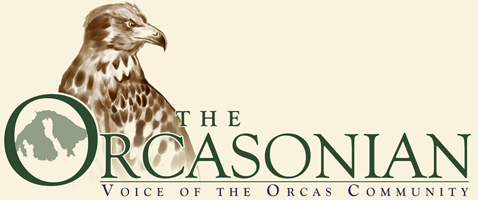The Eastsound Planning Review Committee (EPRC) spent much of their Nov. 5 meeting discussing the Critical Areas Ordinance (CAO) update, which is the subject of field trips and public discussion on Orcas this Thursday, Nov. 12.
New this month to the EPRC was member Ted Tidrington. Present were EPRC members Patty Miller, Gulliver Rankin, Mindy Kayl, Fred Klein and Bob Connell. Audrey Moreland, EPRC member, was absent. Also in attendance at the meeting were many county staff and one of the largest turnouts at the regular monthly EPRC meetings.
As stated by EPRC member Miller, the CAO discussion centered on how proposed changes, “designed to protect critical areas, might impact service provider’s ability to meet their commitment to serve the expanded UGA population.”
Carl Yurdin, Eastsound Sewer and Water District Commissioner, said that the district’s concerns were failed septic systems and the maintenance of water quality. “Whatever we do, our prime goal is to make sure there is safe, adequate drinking water in Eastsound.”
Yurdin said that limiting buildable areas was “a very serious aspect,” of the ordinance update. “It’s a fundamental thing that people don’t seem to get a handle on how important it is… to the well-being of the population.
”This is a very simple message: without this being taken care of a lot of the other stuff will disappear. We’re in good shape now, but we don’t know what the changes will be. As a general principle, the sewer district will respond to the public health,” Yurdin said.
He added that the Sewer District has sent two statements prepared in 2008, he said, to the County Council and the Planning Commission regarding their concerns about the CAO update and what its ramifications will be.
EPRC member Bob Connell commented that a study recently commissioned will help define the situation with “good hard facts.”
Yurdin replied that the study shows the recharge areas and indicates that it will take 10 years for water to work its way out. More data and specific information will be included in the study, which should produce definitive results in the next few weeks
Paul Kamin, General Manager of the Eastsound Water Users Association, (EWUA) spoke to the “potential impact that [the CAO update] creates for future water sources in our service area.”
With the biggest water systems all being surface water-dependent, Kamin said that the CAO update ordinance could “create additional capital expense burdens to existing members.” This is in conflict with the EWUA’s policy that “whatever growth occurs must pay for itself.”
Kamin displayed a map showing “the Frazier Parcel,” as a potential for future water development which “could be equal to Purdue Lake” (which currently provides half of the water supply for the EWUA.)
However, because large-mouth bass have been introduced upstream, all the downstream habitat is classified as fish-bearing, which “which increases the setbacks and potential mitigation costs or $200,000 to $500,000 per acre,” Kamin said. He estimated that the project may cost “$5 million in mitigation as well as $5 million development costs.”
The committee discussed if there were concurrence between UGA growth goals and CAO Protections goals.
Kamin remarked that the substantial expense for mitigation “and that’s not growth — that’s existing members on the hook for those changes.”
The group decided to invite Shireene Hale, County Planner, to make sure they were not misinterpreting shoreline or capital public facilities details in the ordinance to grapple with the problem of the expense of mitigation and the lack of mitigation plans.
Klein said that although state and local laws mandate wetland protection, “Buffers are supposed to be decided locally.
“What’s the boundary between protection and habitable use? I’m particularly worried about that species called the ‘blue- collar worker.’ “
The 150-foot buffer is recommended in the draft CAO ordinance update, not mandated. Miller said that the issue paper released by the County in preparation for the Nov. 12 workshops, requires protection of critical areas, considering “best available science” when setting buffer standards. “Locally, you’re responsible for setting buffers but have to show you’ve considered best available science or establish a monitoring mechanism.
“The ‘best available science’ is a little fuzzier than we’d like it to be,” Miller said.
She summarized Kamin’s concerns as:
- CAO update will discourage growth in Eastsound UGA
- CAO update will require extremely expensive mitigation costs to existing and new EWUA members in the development process
Terry Turner, from OPALCO, summarized his reading of the CAO updates, saying, “When it talks about mitigation activities, it looks so complicated that it makes everybody afraid it’s going to be crazy.”
Turner described OPALCO’s current method of site mitigation and said, “with some erosion control … I can’t imagine why our mitigation needs to be very complicated.” He suggested that Critical Areas Stewardship Plans (CASP) “could probably address 95% of our activities.”
He proposed “an over-reaching plan for all utilities work so you don’t have to do a new plan whenever you want to do work in a wetlands area.”
The EPRC committee then turned to identifying the capital facilities plans within the CAO update that they’d want to see addressed.
Kayl asked if the group wanted to focus specifically on utilities.
County Council member Richard Fralick suggested the committee may want to send the council and the Planning Commission a letter stating “you’d like some consideration of an urban buffer, [which would have] smaller impact on the [Eastsound] UGA.”
Kayl said that buffer standards would need to be not just local, but “site-dependent, depending on the quality of wetlands.”
Klein said, “I’d like us to make a distinction between wetlands related to primary watersheds and isolated wetland.”
Kayl responded, “There’s no such thing as an isolated wetland in Eastsound.”
Rankin pursued the option of requesting county “staff time to find out if it’s legally feasible to have different protection standards for UGAs … Watersheds are large, vs. the basins — which is what we think of in terms of stormwater.”
Bob Gamble, Chair of the county Planning Commission, said it was important to the commission to understand “the problem of Eastsound: with wetlands in the middle of the UGA, you’re in a real bind.”
**If you are reading theOrcasonian for free, thank your fellow islanders. If you would like to support theOrcasonian CLICK HERE to set your modestly-priced, voluntary subscription. Otherwise, no worries; we’re happy to share with you.**








How about pumping water from Cascade Lake and using Otters Pond as a holding pond? That would of course mean dredging Otters Pond, which is clogged with decayed weeds from several decades. Probably the last time it saw a bulldozer was when the Rheems deepened the pond in the early 1940s. Water from the pond now flows downhill into the lake, but as that is a relatively short distance the pumping shouldn’t be an insurmountable problem. Piping water to Eastsound would be mostly downhill.
Water rights from Cascade Lake currently have many homeowners paying excessive bills; perhaps the situation could be acquired by some form of eminent domain?
How about pumping water from Cascade Lake and using Otters Pond as a holding pond? That would of course mean dredging Otters Pond, which is clogged with decayed weeds from several decades. Probably the last time it saw a bulldozer was when the Rheems deepened the pond in the early 1940s. Water from the pond now flows downhill into the lake, but as that is a relatively short distance the pumping shouldn’t be an insurmountable problem. Piping water to Eastsound would be mostly downhill.\
\
Water rights from Cascade Lake currently have many homeowners paying excessive bills; perhaps the situation could be acquired by some form of eminent domain?
How about pumping water from Cascade Lake and using Otters Pond as a holding pond? That would of course mean dredging Otters Pond, which is clogged with decayed weeds from several decades. Probably the last time it saw a bulldozer was when the Rheems deepened the pond in the early 1940s. Water from the pond now flows downhill into the lake, but as that is a relatively short distance the pumping shouldn’t be an insurmountable problem. Piping water to Eastsound would be mostly downhill.
Water rights from Cascade Lake currently have many homeowners paying excessive bills; perhaps the situation could be acquired by some form of eminent domain?